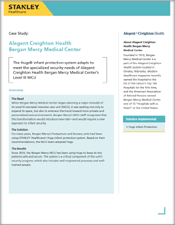Resource:
Alegent Creighton Health Bergan Mercy Medical Center
The Hugs® infant protection system adapts to meet the specialized security needs of Alegent Creighton Health Bergan Mercy Medical Center’s Level III NICU
Overview:
The Need
When Bergan Mercy Medical Center began planning a major remodel of its Level III neonatal intensive care unit (NICU), it was seeking not only to expand its space, but also to embrace the trend toward more private and personalized care environments. Bergan Mercy’s NICU staff recognized that this transformation would introduce new risks—and would require a new approach to infant security.
The Solution
For many years, Bergan Mercy’s Postpartum and Nursery units had been using STANLEY Healthcare’s Hugs infant protection system. Based on their recommendations, the NICU team adopted Hugs.
The Results
Since 2010, the Bergan Mercy NICU has been using Hugs to keep its tiny patients safe and secure. The system is a critical component of the unit’s security program, which also includes well-engineered processes and welltrained people.
Challenges Faced
Bergan Mercy Medical Center operates the Alegent Creighton Health’s Tertiary Level III neonatal intensive care unit (NICU). In 2009, the Omaha-based hospital began planning a remodel and move for this fast-growing unit. As NICU Manager Tracy Meyers notes, the move was intended not only to address the need for more space, but also to address an evolution in NICU care.
Anyone who has visited a NICU in the past will likely remember the traditional ward-style units. Historically, NICUs were dominated by a single large, open space with multiple cribs and incubators for babies receiving all different types and levels of care. Meyers explains that as babies now survive at earlier gestational ages, the traditional one-room-fits-all approach no longer supports developmentally appropriate care for the most premature infants.
“Their neurological systems simply aren’t mature enough to process ‘normal’ levels of light and sound,” she says. “However, restricting light and sound can have negative effects on the Circadian rhythms of other NICU babies and their families.”
The traditional wards also resulted in ongoing privacy challenges. For example, it was often difficult to protect the confidentiality of conversations between clinicians and families, and learning of changes in one baby’s condition could be traumatic to another’s family. Meanwhile, breastfeeding mothers have often lacked private spaces for nursing their infants in a NICU.
Scrutiny on Security
In light of those considerations, Bergan Mercy made a strategic decision to transition its Level III NICU from an open ward to private rooms. Following the move to the remodeled unit in November 2010, the NICU now offers 36 beds in 28 private rooms and four double-occupancy rooms.
Though highly beneficial to NICU babies and their families, private rooms also introduced new security risks. In a single, open room, it was far easier for staff to keep an eye on activity in the NICU and to manage the flow of people in and out of the unit. Additionally, clinicians were able to communicate with each other relatively easily.
With so many individual rooms—and a growing emphasis on families spending time with the babies—security would become more important and more challenging for Meyers and her team. No longer gathered in a single space, NICU staff would also have to use pagers and wireless phones to communicate with each other.
Compounding the complexities of Bergan Mercy’s individual rooms were some “inherited” physical risks: “Because we were remodeling an existing building (previously the Labor & Delivery unit), we weren’t able to incorporate all of the safety barriers that we could have if we had built from the ground up,” Meyers says. “For instance, we have two stairwells and an elevator, which were huge security concerns for our NICU.”
Embracing Hugs
As they planned the move, Meyers and her team took a hard look at security processes and procedures.
Bergan Mercy Medical Center’s Postpartum and Nursery units were longtime users of STANLEY Healthcare’s Hugs infant protection system. They encouraged Meyers to adopt the system in the NICU, as well. At first, she says, she was skeptical: “I knew that Hugs was a great product and was providing a high-quality system for other areas of the hospital. But I also knew that the tags were likely to be too large for some of our tiniest preemies.”
She acknowledges that many NICU babies are hooked up to ventilators and other equipment with built-in alarms, and using those systems for security may seem like an obvious choice. However, Meyers says those systems can’t be counted on as “alarms” in and of themselves since potential abductors, such as non-custodial parents, might be able to track opportunities to bypass the equipment alarms.
Thus, Meyers and her team recognized the need to tag their babies using the Hugs system. They also faced a key question: Could the unit really achieve security by tagging some but not all infants? In the long run, she says, the answer was “yes.”
Implementing a Robust Plan
Meyers and her team started by determining which infants could safely wear the tags. Some of the unit’s occupational therapists worked with the tags, evaluating their likely impact on babies of different sizes. What they concluded—and what formed the basis of the NICU’s current policy—is that babies weighing at least 1,500 grams have the body mass and strength to safely wear a Hugs tag. Babies under 1,500 grams do not wear a tag.
Each Tuesday, the NICU nurses update the babies’ weight charts for the hospital pharmacy. That chart now includes an additional column for Hugs tags—providing a simple, easy and effective means of identifying when babies reach the tag “milestone” of 1,500 grams. And for babies who are over 1,500 grams, the tags are rotated to the opposite extremity each week to ensure skin integrity and to support appropriate fit as the babies grow.
The Hugs technology is one enabler of the unit’s security; people and processes are the others. Leading up to the 2010 move, the NICU staff underwent extensive computer-based and in-person training on the Hugs system in particular and security in general. (The staff continues to use STANLEY Healthcare’s computerbased resources for training and competency validation.)
“Hugs is a wonderful product, and having the tags in place gives NICU families a sense of security,” she says. “However, Hugs alone doesn’t create a secure unit. It’s the increased awareness and vigilance of the staff and how you manage the unit that leads to security.”
With multiple instances of Hugs at the hospital, personnel appreciate the system’s ability to assign a unit code to each alarm. Meyers notes that nuisance alarms are extremely rare in the NICU, and when an alarm sounds, staff are trained to take note. Thus, each alarm helps maintain staff awareness of security measures. Meyers says it’s important that staff members don’t just hit “Clear” when notified of a loose tag: “Our policy is to physically go into the room and check the baby with the loose tag alarm.”
Finding the Right Fit
Just as every NICU baby requires personalized care, Meyers says each NICU will need to develop its own policies and procedures when using the Hugs system. She encourages her peers to find security processes that work well with existing processes. Finally, she emphasizes the importance of educating NICU staff about security and infusing security throughout day-to-day operations.
“By keeping staff compliant with and aware of our security processes and procedures, we keep our babies safe every day,” she concludes.

